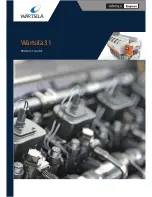
TDI
T
URBO
T
WIN
™
FROM
TECH DEVELOPMENT
Page 6
Publication: T3-790, Rev. 2
Issued January 9, 2013
the Motor(s).
Motor supply & exhaust lines and components should
be dry-fitted for proper alignment /location prior to final
assembly.
All pipe threaded joints should be sealed with Loctite
Pipe Thread Sealant (TDI P/N 9-94085) or equivalent,
for leak tight joints prior to final assembly. Be sure to
tighten all joints to proper torque after final assembly.
The installation of the Motor using natural gas is similar
to the air installation except all fittings, piping, valves
and regulators must be compatible with natural gas
and gas industry regulations.
WARNING
When using natural (or combustible) supply gas
(e.g. methane gas) must be piped to a safe location,
routed and terminated according to industry codes
and local regulations.
NOTE
On low pressure applications, if the supply line is
longer than 40 feet, piping size may need to be
increased to minimize dynamic flow losses through
piping and ensure specified output. Similarly, exhaust
piping length & diameter must not induce back
pressure above 10 psig
On higher supply pressures, a regulator or manual
valve may be used to limit dynamic operating and drive
motor speed (RPM).
See Motor Performance Chart
WARNING
Be sure that any/all piping &/or tubing used, meets
applicable requirements and that no leaks are
present following line installation or thereafter.
CAUTION
There is often weld slag, grindings, thread shavings,
hardened compounds and other heavy debris in new
package piping & at new site installations. Therefore,
at commissioning TDI recommends a purge or “blow-
down” of Motor supply lines to prevent damage to the
Motor. While
T30-M TURBOTWIN
Motors are highly
tolerant of moisture & fine contamination, Motor life
can be increased by use of a coarse #40 mesh
strainer upstream in the motor supply line
NOTE
Expensive moisture abatement (air/gas drying) is not
required, as this has no effect on the Motors.
2.3 MOTOR CONTROLS
Preferred Motor supply control valve is a pilot-operated
type, which is pneumatically or electrically actuated. A
manual valve may also be used.
CAUTION
SET UP
– Motor supply pressure “matching” will
control motor speed and is recommended on all
installations of the T30-M.
Do Not
use Motor’s (data
plate
)
Max Operating Pressure rating as the default
supply pressure setting. (also See Section 2.5)
Motor supply pressure (flow restriction) or a pressure
regulator
is required
:
Where Motor supply pressure exceeds
dynamic
Motor operating pressure (measured
at the inlet port while motor is running. (
Over-
pressure)
.
Where “default” Motor supply pressure (e.g.
engine fuel gas pressure or starting pressure)
produces Motor output speeds beyond what is
specified for the application. (
Over-speed
).
Where
motor
over-speed
, occurs even when
Motor is operated (dynamically) at a pressure
below the Motor’s Maximum Operating Max.
Over-pressure & Over-speed
reduce life of Motor &
driven equip (oil pump) & wastes supply air/gas
(increases operating costs).
2.4 INLET PRESSURE CHECK PORT
(checking dynamic operating pressures)
A 1/8" NPT port is located on the Motor housing, at
the air inlet. This port is used to check the dynamic
supply pressure (at the Motor when the Motor is
operating). To check dynamic pressure, remove the
1/8" NPT pipe plug and save for later use. Install a
pressure gauge to read at this port. Using Loctite Pipe
Thread Sealant or equivalent, replace 1/8” NPT pipe
plug upon completion of pressure check.
This pressure monitoring gauge may also be
permanently installed. Alternately, a pressure
transducer may be installed at the pressure check port
and electrical lines routed to a digital display or panel

































